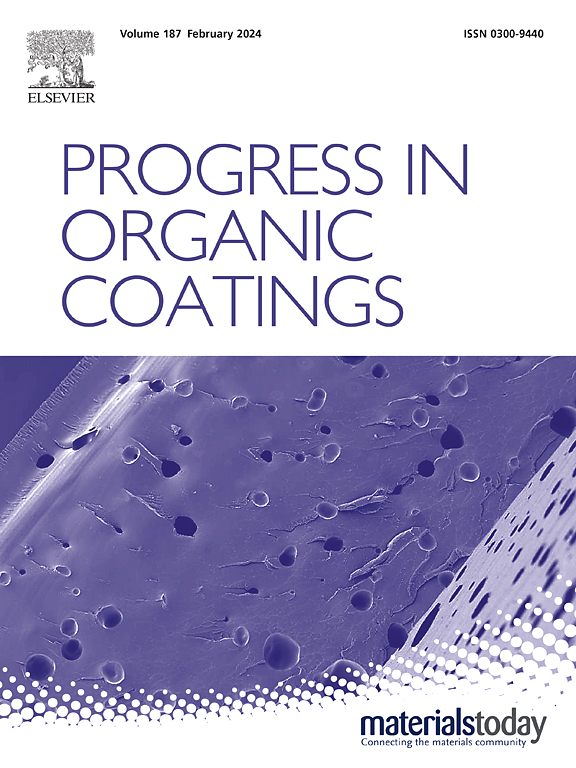Progress in tailor-made of anti-fouling coating strategies for marine fish farming cages based on green synthesis of zinc oxide nanoparticles from Avicennia marina leaves
IF 6.5
2区 材料科学
Q1 CHEMISTRY, APPLIED
引用次数: 0
Abstract
The development of environmentally friendly paints has become a significant goal for researchers. In this study, zinc oxide nanoparticles were synthesized using a green method involving mangrove plants and evaluated as a paint additive to control marine fouling on fish farming cages. The size and characteristics of zinc oxide nanoparticles were evaluated using XRD, FTIR, and TEM analyses. The effectiveness of the nanoparticles was assessed through antibacterial and antialgal tests, as well as by examining their lethal effects on two species, Amphibalanus amphitrite and Artemia salina, in laboratory settings. The minimum inhibitory concentration (MIC) of zinc oxide nanoparticles against the bacteria Staphylococcus aureus and Escherichia coli was determined to be 6.25 and 25 mg/L, respectively, after 48 h. At a concentration of 800 mg/L, zinc oxide nanoparticles inhibited the growth rates of the algae Spirulina platensis, Dunaliella salina, and Chaetoceros muelleri by 90.88 %, 94.06 %, and 92.49 %, respectively, demonstrating their high potential as an effective inhibitor. An epoxy resin paint containing 2 %, 4 % or 8 % zinc oxide nanoparticles was used as an antifouling solution. The tests were conducted in a sea environment at depths of 1 m, 5 m and 10 m below the surface, with the samples left for 90 days to evaluate their performance over time. Increasing the concentration of zinc nanoparticles in the paint enhanced its the antifouling performance of the paint increases. By the end of the experiment, seven groups of organisms were identified: Ascidiacea (1 species), Polychaeta (1 species), Gastropoda (2 species), Globothalamea (1 species), Tubothalamea (1 species), Thecostraca (1 species), and Bivalva (9 species). At all three depths tested, the fewest species were found on the paint containing 8 % zinc oxide nanoparticles. Given their strong antifouling effectiveness, zinc oxide nanoparticles could be a promising solution for marine biofouling.
基于绿色合成海鱼叶氧化锌纳米颗粒的海洋养鱼网箱防污涂料策略研究进展
开发环保涂料已成为研究人员的一个重要目标。在这项研究中,氧化锌纳米颗粒采用绿色方法合成,涉及红树林植物,并评估作为油漆添加剂,以控制海洋污染的养鱼网箱。采用XRD、FTIR和TEM等分析手段对氧化锌纳米颗粒的尺寸和特性进行了表征。通过抗菌和抗藻试验,以及在实验室环境中检查它们对两种物种——Amphibalanus amphitrite和Artemia salina的致死效果,评估了纳米颗粒的有效性。实验结果表明,氧化锌纳米颗粒对金黄色葡萄球菌和大肠杆菌的最小抑制浓度(MIC)分别为6.25和25 mg/L。在800 mg/L浓度下,氧化锌纳米颗粒对platulina、Dunaliella salina和muelleri毛囊藻的生长抑制率分别为90.88%、94.06%和92.49%,表明氧化锌纳米颗粒是一种极具潜力的有效抑制剂。采用含有2%、4%或8%氧化锌纳米粒子的环氧树脂涂料作为防污溶液。测试在海平面以下1米、5米和10米的海洋环境中进行,样品放置90天,以评估其随时间变化的性能。随着锌纳米粒子浓度的增加,涂料的防污性能也随之提高。实验结束时,共鉴定出海鞘目(1种)、多毛目(1种)、腹足目(2种)、Globothalamea(1种)、Tubothalamea(1种)、theecostraca(1种)、Bivalva(9种)等7类生物。在所有三个深度测试中,在含有8%氧化锌纳米颗粒的油漆上发现的物种最少。鉴于氧化锌纳米颗粒具有很强的防污效果,它可能是一种很有前途的海洋生物防污解决方案。
本文章由计算机程序翻译,如有差异,请以英文原文为准。
求助全文
约1分钟内获得全文
求助全文
来源期刊

Progress in Organic Coatings
工程技术-材料科学:膜
CiteScore
11.40
自引率
15.20%
发文量
577
审稿时长
48 days
期刊介绍:
The aim of this international journal is to analyse and publicise the progress and current state of knowledge in the field of organic coatings and related materials. The Editors and the Editorial Board members will solicit both review and research papers from academic and industrial scientists who are actively engaged in research and development or, in the case of review papers, have extensive experience in the subject to be reviewed. Unsolicited manuscripts will be accepted if they meet the journal''s requirements. The journal publishes papers dealing with such subjects as:
• Chemical, physical and technological properties of organic coatings and related materials
• Problems and methods of preparation, manufacture and application of these materials
• Performance, testing and analysis.
 求助内容:
求助内容: 应助结果提醒方式:
应助结果提醒方式:


